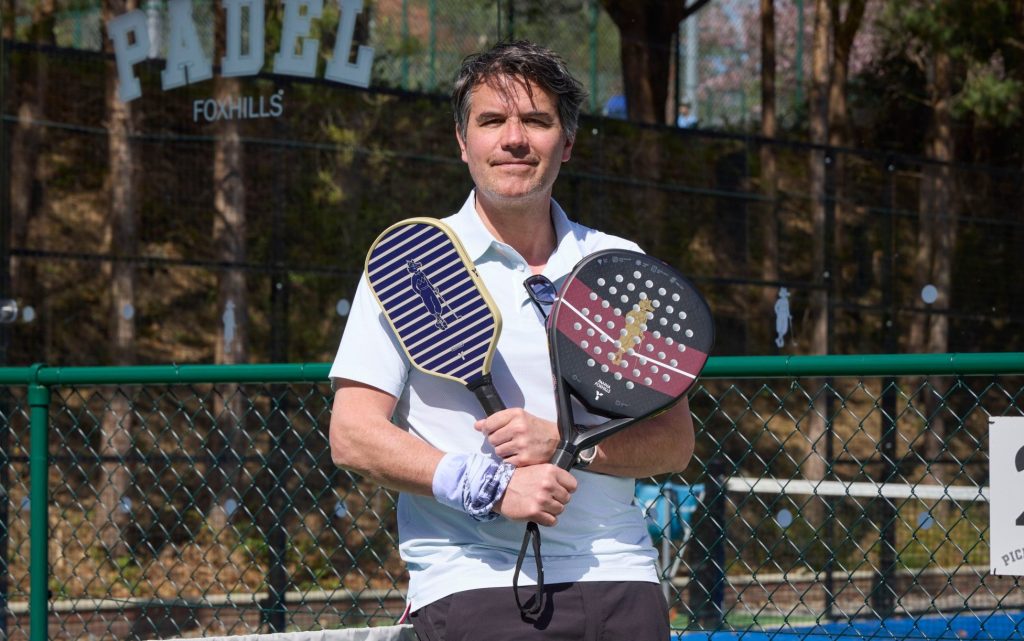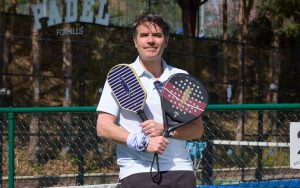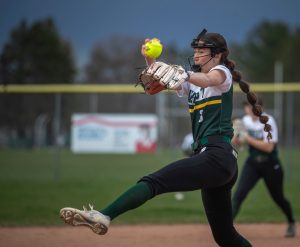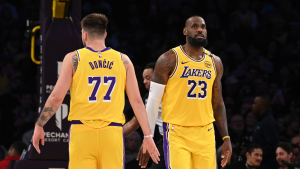
On a bright spring morning at Foxhills country club in Surrey, the padel and pickleball courts echo with the sound of balls popping off rackets. There are 12 players spread across the three padel courts – some complete beginners, others more proficient – while on the adjoining pickleball courts a handful of kids, off school for the Easter holidays, are practising keenly.
I’m here to find out why these two racket sports are taking over the lives of middle-class, middle-aged people all over Britain who might once have been down the tennis club or on the golf course. (In fact, padel is the world’s fastest growing sport, and pickleball America’s, and as I discover, there’s a lot of competition between the two sports).
Overseeing the action at Foxhills is the club’s head of rackets, Pippa Vincent, who explains how both are growing in popularity among her members, thanks to the ease with which beginners can start rallying. Unlike tennis, which usually requires months of coaching before you’re competent enough to play a match, with padel and pickleball, just a smidgeon of hand-eye coordination allows for competitive play within hours. Add to that the slower-bouncing balls and the smaller court sizes – padel measures 20 metres by 10 metres, while pickleball is much smaller, the same as a badminton court – and it all makes for two very accessible racket sports, for all ages and skill levels.

In other words, you don’t have to be an athlete to take part – and the chance of embarrassing yourself is pretty small, unlike on a tennis court. And even better, there’s a huge social networking aspect to both, meaning that once you’ve exerted yourself during a match, a gin and tonic or Aperol Spritz beckons as a reward afterwards – and maybe even a business deal.
The difference between padel and pickleball
Foxhills is rare in that it offers both. However, as Pippa points out, padel is by far the more popular, even if, among beginners, there is a bit of confusion between the two.
It wasn’t long before Pippa had lured me onto the courts. Although I’m confident in tennis, squash and badminton, when it comes to padel, I’m very green. For pickleball I’m a complete debutant.

As I quickly learned, both sports are focused on doubles play, although singles is possible in pickleball. Padel courts must be enclosed – Foxhills’, for example, feature glass screens at both ends and steel grilles along the sides. Pickleball has an open court, meaning facilities can easily be marked out on existing surfaces, and it’s unusual in that there are rectangular boxes either side of the net, known as kitchens, in which volleying is not permitted.
If you need evidence of padel’s domination, then consider this: according to the racket sport’s world governing body, there are more than 30 million players worldwide. French president Emmanuel Macron, actress Eva Longoria, footballer David Beckham and tennis player Rafa Nadal love to play. British rapper Stormzy has invested in a fledgling network of clubs in the UK. And social media is ablaze with jaw-droppingly athletic rallies from the professional tours.

Pickleball is focused more on the United States, with an estimated 20 million players in that country alone.
A-list aficionados
While padel is a fairly democratic sport across its Latin heartlands, in the Anglo-Saxon world at least, it has fostered a very upmarket image.
US and Middle Eastern brands are pouring millions into the sport. Qatar Airways, for example, is headline sponsor of the professional world tour. Italian fashion house Valentino has collaborated with the Matcha Club in Dubai, while British brand Dunhill sponsored an invitation-only tournament at west London’s Hurlingham Club. Both Prada and Versace have released branded padel rackets and accessories.

One fashion brand at the forefront of padel’s ascendancy is London-based clothing company Pulco, named after Acapulco, in Mexico, where the sport was invented. Founder Joe Middleton explains how many wealthy Brits first discovered padel while holidaying in luxury resorts in Spain and the Algarve. On returning home, and facing a dearth of facilities, they were willing to pay up to £100 an hour to rent a court.
“There was a supply and demand problem for padel courts, especially in expensive property areas like London,” Middleton says. “It costs thousands to build a court, and developers understandably want to recoup their construction costs.”
But as Middleton stresses, it’s not old-school moneyed classes who have embraced the sport. “The last thing players want is the country club image with all white clothing, polo shirts for the men and pleated skirts for the women. Yes, it’s people in professional jobs who are playing, but it’s got a cool vibe to it. Padel is more Soho House than Pall Mall gentleman’s club. It’s what snowboarding is to skiing, or what surfing is to the yacht club.”

Padel has also proved ideal for business networking – as has pickleball – thanks to the proximity of the players on the court. The slower rallies and underarm serves mean players of different skills and athletic abilities can enjoy matches together, unlike in other racket sports. “Padel has become a major factor in corporate hospitality,” Middleton adds.
Padel and pickleball at war
With both sports now vying for the attention of the middle classes, which one should you opt for, though?
According to the British governing bodies of each sport – the Lawn Tennis Association for padel and Pickleball England for pickleball – there’s now no shortage of clubs and courts offering facilities. The LTA claims there are over 800 padel courts and 65,000 regular players in Britain and rising.
Pickleball England claims its sport is offered at nearly a thousand venues in England and Wales, with 45,000 regular players. Both sports are keen to attract new players, so there’s a healthy rivalry. Indeed, the LTA recently attempted to wrest governance of pickleball from Pickleball England, but Sport England ruled in favour of the latter.

Karen Mitchell is chair of Pickleball England. She is proud to have resisted the LTA’s takeover bid, viewing it as a victory for David over Goliath. She admits her sport lacks the financial clout of the LTA but is determined it will grow.
“Do I think pickleball could be bigger than padel? Absolutely, I do!” she insists. “Because we will get facilities; we will be in schools and universities and leisure centres up and down the country. We have the potential. Our goal for 2030 is a million players across England. It is a bold goal, but we think it’s achievable.”
One advantage she has is that a basic pickleball court can be chalked out on any small patch of asphalt, whereas padel requires a properly constructed enclosure. Mitchell also claims her sport is far cheaper when it comes to hiring courts.
How padel and pickleball started
The creation stories behind both sports share certain similarities. They were born in the 1960s, in middle-class back gardens, although thousands of miles apart – one in Mexico and one in the United States.
It was future Republican Party politician Joel Pritchard who devised pickleball, in 1965, at his summer residence on Bainbridge Island in Washington State, using leftover equipment from other racket sports. There are several stories as to the unusual name, ranging from his dog Pickles to the US rowing term ‘pickleboat’, meaning a team comprised of leftover crew from other boats.
Four years later, Mexican businessman Enrique Corcuera invented padel at his summer home in Acapulco. With little space in his garden, he kept it small and built surrounding walls to stop the balls rolling onto his neighbour’s land. Padel is a Spanish version of the word paddle, the name of the perforated racket used.

From Mexico, Corcuera’s sport migrated to Spain – thanks in no small part to his well-connected friend, Prince Alfonso of Hohenlohe-Langenburg – and from there across Europe and the wider world. By 2005, it had established a professional league. Nowadays the Premier Padel Tour is the leading international competition, totally dominated by Spanish and Argentinian players.
Pickleball has also spread globally, but its heartland is still very much the United States where two professional leagues are vying for attention.
Foxhills fans
Back at Foxhills, the amateur versions of these sports are in rude health. Trying out both for the first time are husband and wife James and Kat Chase, a 39-year-old financial director and 37-year-old corporate lawyer from Camberley. Already proficient at tennis and squash, they see padel and pickleball as less technical sports they might eventually share with their two young sons.

Playing alongside them are Joy Witting, a 66-year-old retired teacher from Ascot, and Debbie Thomas, a 62-year-old retired nursery teacher from Virginia Water. Both are experienced in tennis but recent converts to padel and, to a lesser degree, pickleball.
“Being in a contained area, you’re not picking up balls all the time,” Debbie says of padel. “So rallies are longer. With smaller courts and underarm serves, it’s also easier on your body.” Joy says she knows several racket sports players who have switched from tennis to padel for this reason.

I later spoke to Mollie Knaggs, Britain’s top-ranked female pickleball player, who took up the sport after severe shoulder pain sidelined her from tennis. “You can play with friends and family instantly,” said the 27-year-old, championing the accessibility of pickleball. “If you’re playing against someone a level up who hits the ball a bit harder, or places it better, you can still block the ball back and make it difficult for them without having all the correct technique.”
Mitchell, at Pickleball England, is convinced her sport can sit harmoniously alongside padel, and sees a bright future for both codes.
“I don’t see us in competition,” she concludes. “I think we can coexist. We have a lot of players that play both. I fully endorse anything that gets people off the couch, active and socialising.”
Padel vs pickleball: the rules
Courts
Padel courts measure 20m by 10m, with enclosed walls (usually glass or brick) and steel grilles. Pickleball courts measure 13.41m by 6.1m (the same as a badminton court) and are open.
Balls
Padel uses low-pressure tennis balls, while pickleball’s are smaller, perforated and plastic.
Rackets
Padel rackets, perforated with holes, must measure no longer than 45.5cm, no wider than 26cm, and no thicker than 38mm. Pickleball paddles must not exceed 43.2cm in length, 20.96cm in width, and 1.59cm in thickness.

Basic rules
Like other racket sports, if you fail to return the ball, you lose the point. Up to one bounce is permitted. Both sports feature underarm serving. Padel is played as doubles, pickleball as both doubles and singles. In padel you can play balls off the rear and side walls. In pickleball there is a no-volley zone on both sides of the net, called the kitchen. It’s also possible to play pickleball without a net, buy a portable one, or adapt a tennis net.
Scoring
Padel mirrors tennis scoring while in pickleball games run to 11 points with only the server able to win points.
How fit must you be?
Padel courts are larger, with more space to cover. The surrounding walls mean points often continue over lengthy rallies. Pickleball courts are smaller, suiting less athletic players. The underarm serving in both codes is easier on the upper body.
Where to play
Visit www.lta.org.uk for padel; www.pickleballengland.org and www.pickleballscotland.org for pickleball.
Thanks to Foxhills club & resort

On a bright spring morning at Foxhills country club in Surrey, the padel and pickleball courts echo with the sound of balls popping off rackets. There are 12 players spread across the three padel courts – some complete beginners, others more proficient – while on the adjoining pickleball courts a handful of kids, off school for the Easter holidays, are practising keenly.
I’m here to find out why these two racket sports are taking over the lives of middle-class, middle-aged people all over Britain who might once have been down the tennis club or on the golf course. (In fact, padel is the world’s fastest growing sport, and pickleball America’s, and as I discover, there’s a lot of competition between the two sports).
Overseeing the action at Foxhills is the club’s head of rackets, Pippa Vincent, who explains how both are growing in popularity among her members, thanks to the ease with which beginners can start rallying. Unlike tennis, which usually requires months of coaching before you’re competent enough to play a match, with padel and pickleball, just a smidgeon of hand-eye coordination allows for competitive play within hours. Add to that the slower-bouncing balls and the smaller court sizes – padel measures 20 metres by 10 metres, while pickleball is much smaller, the same as a badminton court – and it all makes for two very accessible racket sports, for all ages and skill levels.

In other words, you don’t have to be an athlete to take part – and the chance of embarrassing yourself is pretty small, unlike on a tennis court. And even better, there’s a huge social networking aspect to both, meaning that once you’ve exerted yourself during a match, a gin and tonic or Aperol Spritz beckons as a reward afterwards – and maybe even a business deal.
The difference between padel and pickleball
Foxhills is rare in that it offers both. However, as Pippa points out, padel is by far the more popular, even if, among beginners, there is a bit of confusion between the two.
It wasn’t long before Pippa had lured me onto the courts. Although I’m confident in tennis, squash and badminton, when it comes to padel, I’m very green. For pickleball I’m a complete debutant.

As I quickly learned, both sports are focused on doubles play, although singles is possible in pickleball. Padel courts must be enclosed – Foxhills’, for example, feature glass screens at both ends and steel grilles along the sides. Pickleball has an open court, meaning facilities can easily be marked out on existing surfaces, and it’s unusual in that there are rectangular boxes either side of the net, known as kitchens, in which volleying is not permitted.
If you need evidence of padel’s domination, then consider this: according to the racket sport’s world governing body, there are more than 30 million players worldwide. French president Emmanuel Macron, actress Eva Longoria, footballer David Beckham and tennis player Rafa Nadal love to play. British rapper Stormzy has invested in a fledgling network of clubs in the UK. And social media is ablaze with jaw-droppingly athletic rallies from the professional tours.

Pickleball is focused more on the United States, with an estimated 20 million players in that country alone.
A-list aficionados
While padel is a fairly democratic sport across its Latin heartlands, in the Anglo-Saxon world at least, it has fostered a very upmarket image.
US and Middle Eastern brands are pouring millions into the sport. Qatar Airways, for example, is headline sponsor of the professional world tour. Italian fashion house Valentino has collaborated with the Matcha Club in Dubai, while British brand Dunhill sponsored an invitation-only tournament at west London’s Hurlingham Club. Both Prada and Versace have released branded padel rackets and accessories.

One fashion brand at the forefront of padel’s ascendancy is London-based clothing company Pulco, named after Acapulco, in Mexico, where the sport was invented. Founder Joe Middleton explains how many wealthy Brits first discovered padel while holidaying in luxury resorts in Spain and the Algarve. On returning home, and facing a dearth of facilities, they were willing to pay up to £100 an hour to rent a court.
“There was a supply and demand problem for padel courts, especially in expensive property areas like London,” Middleton says. “It costs thousands to build a court, and developers understandably want to recoup their construction costs.”
But as Middleton stresses, it’s not old-school moneyed classes who have embraced the sport. “The last thing players want is the country club image with all white clothing, polo shirts for the men and pleated skirts for the women. Yes, it’s people in professional jobs who are playing, but it’s got a cool vibe to it. Padel is more Soho House than Pall Mall gentleman’s club. It’s what snowboarding is to skiing, or what surfing is to the yacht club.”

Padel has also proved ideal for business networking – as has pickleball – thanks to the proximity of the players on the court. The slower rallies and underarm serves mean players of different skills and athletic abilities can enjoy matches together, unlike in other racket sports. “Padel has become a major factor in corporate hospitality,” Middleton adds.
Padel and pickleball at war
With both sports now vying for the attention of the middle classes, which one should you opt for, though?
According to the British governing bodies of each sport – the Lawn Tennis Association for padel and Pickleball England for pickleball – there’s now no shortage of clubs and courts offering facilities. The LTA claims there are over 800 padel courts and 65,000 regular players in Britain and rising.
Pickleball England claims its sport is offered at nearly a thousand venues in England and Wales, with 45,000 regular players. Both sports are keen to attract new players, so there’s a healthy rivalry. Indeed, the LTA recently attempted to wrest governance of pickleball from Pickleball England, but Sport England ruled in favour of the latter.

Karen Mitchell is chair of Pickleball England. She is proud to have resisted the LTA’s takeover bid, viewing it as a victory for David over Goliath. She admits her sport lacks the financial clout of the LTA but is determined it will grow.
“Do I think pickleball could be bigger than padel? Absolutely, I do!” she insists. “Because we will get facilities; we will be in schools and universities and leisure centres up and down the country. We have the potential. Our goal for 2030 is a million players across England. It is a bold goal, but we think it’s achievable.”
One advantage she has is that a basic pickleball court can be chalked out on any small patch of asphalt, whereas padel requires a properly constructed enclosure. Mitchell also claims her sport is far cheaper when it comes to hiring courts.
How padel and pickleball started
The creation stories behind both sports share certain similarities. They were born in the 1960s, in middle-class back gardens, although thousands of miles apart – one in Mexico and one in the United States.
It was future Republican Party politician Joel Pritchard who devised pickleball, in 1965, at his summer residence on Bainbridge Island in Washington State, using leftover equipment from other racket sports. There are several stories as to the unusual name, ranging from his dog Pickles to the US rowing term ‘pickleboat’, meaning a team comprised of leftover crew from other boats.
Four years later, Mexican businessman Enrique Corcuera invented padel at his summer home in Acapulco. With little space in his garden, he kept it small and built surrounding walls to stop the balls rolling onto his neighbour’s land. Padel is a Spanish version of the word paddle, the name of the perforated racket used.

From Mexico, Corcuera’s sport migrated to Spain – thanks in no small part to his well-connected friend, Prince Alfonso of Hohenlohe-Langenburg – and from there across Europe and the wider world. By 2005, it had established a professional league. Nowadays the Premier Padel Tour is the leading international competition, totally dominated by Spanish and Argentinian players.
Pickleball has also spread globally, but its heartland is still very much the United States where two professional leagues are vying for attention.
Foxhills fans
Back at Foxhills, the amateur versions of these sports are in rude health. Trying out both for the first time are husband and wife James and Kat Chase, a 39-year-old financial director and 37-year-old corporate lawyer from Camberley. Already proficient at tennis and squash, they see padel and pickleball as less technical sports they might eventually share with their two young sons.

Playing alongside them are Joy Witting, a 66-year-old retired teacher from Ascot, and Debbie Thomas, a 62-year-old retired nursery teacher from Virginia Water. Both are experienced in tennis but recent converts to padel and, to a lesser degree, pickleball.
“Being in a contained area, you’re not picking up balls all the time,” Debbie says of padel. “So rallies are longer. With smaller courts and underarm serves, it’s also easier on your body.” Joy says she knows several racket sports players who have switched from tennis to padel for this reason.

I later spoke to Mollie Knaggs, Britain’s top-ranked female pickleball player, who took up the sport after severe shoulder pain sidelined her from tennis. “You can play with friends and family instantly,” said the 27-year-old, championing the accessibility of pickleball. “If you’re playing against someone a level up who hits the ball a bit harder, or places it better, you can still block the ball back and make it difficult for them without having all the correct technique.”
Mitchell, at Pickleball England, is convinced her sport can sit harmoniously alongside padel, and sees a bright future for both codes.
“I don’t see us in competition,” she concludes. “I think we can coexist. We have a lot of players that play both. I fully endorse anything that gets people off the couch, active and socialising.”
Padel vs pickleball: the rules
Courts
Padel courts measure 20m by 10m, with enclosed walls (usually glass or brick) and steel grilles. Pickleball courts measure 13.41m by 6.1m (the same as a badminton court) and are open.
Balls
Padel uses low-pressure tennis balls, while pickleball’s are smaller, perforated and plastic.
Rackets
Padel rackets, perforated with holes, must measure no longer than 45.5cm, no wider than 26cm, and no thicker than 38mm. Pickleball paddles must not exceed 43.2cm in length, 20.96cm in width, and 1.59cm in thickness.

Basic rules
Like other racket sports, if you fail to return the ball, you lose the point. Up to one bounce is permitted. Both sports feature underarm serving. Padel is played as doubles, pickleball as both doubles and singles. In padel you can play balls off the rear and side walls. In pickleball there is a no-volley zone on both sides of the net, called the kitchen. It’s also possible to play pickleball without a net, buy a portable one, or adapt a tennis net.
Scoring
Padel mirrors tennis scoring while in pickleball games run to 11 points with only the server able to win points.
How fit must you be?
Padel courts are larger, with more space to cover. The surrounding walls mean points often continue over lengthy rallies. Pickleball courts are smaller, suiting less athletic players. The underarm serving in both codes is easier on the upper body.
Where to play
Visit www.lta.org.uk for padel; www.pickleballengland.org and www.pickleballscotland.org for pickleball.
Thanks to Foxhills club & resort













